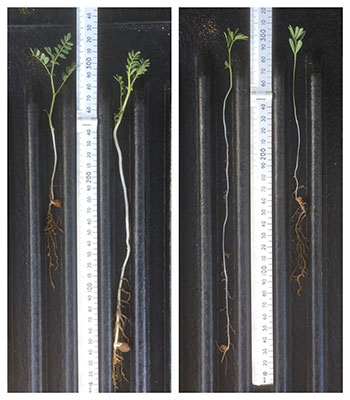As seasonal rainfall and the autumn break become more erratic, it is increasingly challenging to establish crops, particularly in Western Australia’s low and medium-rainfall areas. However, new sowing opportunities could present themselves in years where there is an increase in summer rainfall.
This rainfall, together with small autumn rainfall events, can result in subsurface moisture – deeper than 50 millimetres – being available in the sowing window, which may be enough for germination and establishment.
If moisture is present at depth, deep sowing into this moisture would allow growers to sow and establish pulse and cereal crops with less reliance on the season break, potentially offering yield benefits and allowing for more flexibility in their sowing programs.
As a plant physiologist fascinated by the complexity of farming systems, Dr Sarah Rich from CSIRO brings unique insights to a GRDC-supported postdoctoral project, determining how frequently these sowing opportunities could occur and how deep sowing could help plant species, in particular high-value pulses, chase water.
Dr Rich has had an interest in changing rainfall patterns since her doctorate research into the impacts of waterlogging and flooding on native species. She has extended this interest into research into ‘management-by-environment interactions’ around sowing and emergence in grains.
“Given my interest in below-ground processes, deep-sowing options for Western Australia is a perfect research fit, allowing me to run everything from large field trials to pot studies in the glasshouse,” Dr Rich says.
Model approach
We have modelled soil water availability and sowing opportunities over 50 years in the low and medium-rainfall zones of Western Australia. The results have shown that deep sowing could significantly increase sowing opportunity for not only pulses but also potentially oats and long-coleoptile wheat.
Traditionally, pulses are planted at depths of about 50mm, but the modelling work showed that even a small increase in sowing depth, down to 100mm, can significantly increase the number of sowing opportunities.
Field and pot trials
 Seven-week-old PBA Striker chickpeas and PBA Bolt lentils. The seedlings have been sown at either 50 millimetres or 200mm (the two in the centre). The photo illustrates the ability for these crops to successfully emerge and establish healthy seedlings even when sown at extreme depths. Photo: Sarah Rich, CSIRO
Seven-week-old PBA Striker chickpeas and PBA Bolt lentils. The seedlings have been sown at either 50 millimetres or 200mm (the two in the centre). The photo illustrates the ability for these crops to successfully emerge and establish healthy seedlings even when sown at extreme depths. Photo: Sarah Rich, CSIRO
Closely monitored field trials across three locations and two seasons have been carried out, together with controlled-environment pot experiments assessing genetic variation in emergence and characteristics relating to deep sowing in chickpeas and lentils.
“These trials have shown chickpea and lentil crops can be successfully grown on sands outside the traditional growing areas for these crops in WA,” Dr Rich says.
“Chickpeas, lentils, field peas and vetch can be sown in the field to depths of up to 100mm, with little delay to emergence and no significant impact on establishment.
“We also found there is little genetic variation in emergence of common commercial varieties of chickpeas and lentils, and seed size does not affect the emergence rate from deep sowing.
“However, very small seeds will allocate carbon reserve differently to large seeds, resulting in a lower vigour seedling.
"So there may be a benefit in selecting larger seed size for deeper sowing.”
More information: Dr Sarah Rich, 0432 891 197, sarah.rich@csiro.au

























































